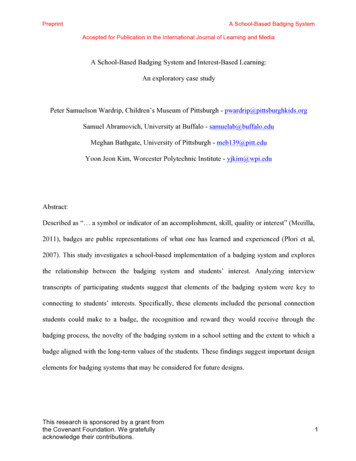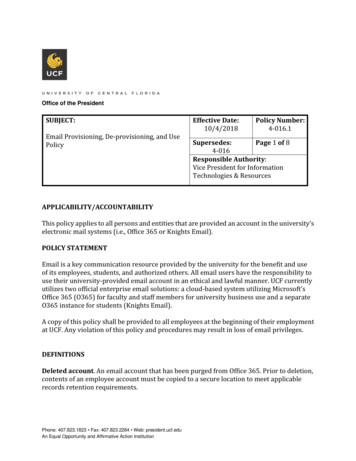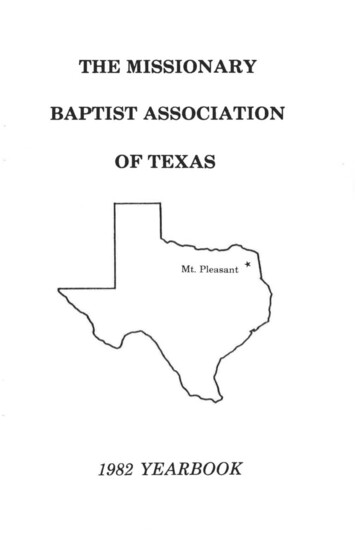
Transcription
PreprintA School-Based Badging SystemAccepted for Publication in the International Journal of Learning and MediaA School-Based Badging System and Interest-Based Learning:An exploratory case studyPeter Samuelson Wardrip, Children’s Museum of Pittsburgh - pwardrip@pittsburghkids.orgSamuel Abramovich, University at Buffalo - samuelab@buffalo.eduMeghan Bathgate, University of Pittsburgh - meb139@pitt.eduYoon Jeon Kim, Worcester Polytechnic Institute - yjkim@wpi.eduAbstract:Described as “ a symbol or indicator of an accomplishment, skill, quality or interest” (Mozilla,2011), badges are public representations of what one has learned and experienced (Plori et al,2007). This study investigates a school-based implementation of a badging system and exploresthe relationship between the badging system and students’ interest. Analyzing interviewtranscripts of participating students suggest that elements of the badging system were key toconnecting to students’ interests. Specifically, these elements included the personal connectionstudents could make to a badge, the recognition and reward they would receive through thebadging process, the novelty of the badging system in a school setting and the extent to which abadge aligned with the long-term values of the students. These findings suggest important designelements for badging systems that may be considered for future designs.This research is sponsored by a grant fromthe Covenant Foundation. We gratefullyacknowledge their contributions.1
PreprintA School-Based Badging SystemAccepted for Publication in the International Journal of Learning and MediaIntroductionEngagement and motivation amongst students is an established challenge to schoolsuccess (Fredricks, Blumenfeld, & Paris, 2004; National Research Council and the Institute ofMedicine, 2004). With the link to learning firmly established, increasing engagement andmotivation in students is sought as the key to implementing ambitious instructional units(Blumenfeld, Kempler, & Krajcik, 2006). While engagement and motivation are constituted in avariety of ways, a key aspect of both is student interest. However, student interest has beenaddressed in schools with mixed results. (e.g., Hidi & Renninger, 2006; Tobias, 1994; Hidi,2000;).Consequently, education reformers are seeking out novel, effective ways to promotestudent interest in formal school settings. Proponents suggest educational badges and badgingsystems as a way to connect and enhance student interests (e.g. Mozilla, 2011). The purpose ofthis study was to identify and explore the connection between student interest and badgesqualitatively and provide documentation of various factors that constitute student interest in thecontext of a badging system in a formal school environment. We conducted a small-scale studyof a school-based badging system: a collaborative project between an independent school, theCovenant Foundation, and Global Kids, Inc. Our goal is to inform potential and current badgingsystem implementations by highlighting relevant motivational factors and to present implicationsfor designers and practitioners of future badging systems.Badges and Learning Environments2
PreprintA School-Based Badging SystemAccepted for Publication in the International Journal of Learning and MediaDescribed as “ a symbol or indicator of an accomplishment, skill, quality or interest”(Mozilla, 2011), badges are public representations of what one has learned and experienced(Plori et al, 2007). Badges have been used to indicate accomplishments, skills, identity, values,credentials, and interests in digital environments (Antin & Churchill, 2011) as well as face-toface environments. In education, badges have also been used to motivate students to set goalsand represent and communicate achievements within a learning community (Abramovich,Schunn, & Higashi, 2013; Abramovich et al, 2011; Halavais, 2011; Higashi et al, 2012). Perhapsthe most well-known educational badges are those of the Boy and Girl Scouts' merit badgesystem. In scouting organizations (e.g. Boy Scouts, Girl Scouts) children can choose a badgebased on their interests, and follow through with activities to meet certain requirements to earnthe badge. For example, a boy scout might select the entrepreneurship merit badge if he isinterested in learning about how to start and run a business. To earn that badge, he will need tocome up with a business plan, and then conduct a feasibility study (Boy Scouts of America,2012). Once he has earned the badge, he can then display it as a representation of a level ofcompetency and accomplishment.Advocates for badges in education commonly point to the potential for badges to act asassessment for expertise or learning typically undocumented by formal education institutions.However, badges are not limited to simply offering an alternative model of credentialing(Joseph, 2012). Badges could connect to student interests and motivate learners by allowing forfeedback and reward outside of traditional assessments. It is this advantage of badges, the extentto which a badging system can connect to learners’ interests and motivation that we investigatein our study.3
PreprintA School-Based Badging SystemAccepted for Publication in the International Journal of Learning and MediaTheoretical BackgroundIn order to investigate the ways in which a badging system can connect to interest-basedlearning, we drew on two motivational theories: Expectancy-Value Theory (Eccles, 1987; Eccleset al., 1983; Eccles & Wigfield, 2002; Wigfield & Eccles, 2000) and Cognitive EvaluationTheory (Deci & Ryan, 1985; Ryan & Deci, 2000). While a variety of theories could be utilized toinvestigate interest-based learning, these two theories were chosen due to their relationship tochildren’s motivation and persistence in an activity and serve as a lens by which we coulddetermine what motivational aspects of badges can exist.Expectancy-Value TheorySince expectancy-value theory was conceptualized (Eccles et al., 1983), it has beenapplied extensively to a variety of settings including both academic and non-academic contexts(Eccles & Wigfield, 1995). Expectancy-Value (E-V) considers the generally positive relationshipbetween individuals’ expectancies, or expectations, for performance and the reasons they value aparticular task or domain. These expectations and values are thought to be domain and taskspecific, as people can hold varying levels of expectations paired with different values towardsspecific content (e.g., mathematics, video games). Contextual changes between content areas,such as how information is conveyed or how learning is demonstrated, can be associated withdistinct social and cognitive factors that may affect a child’s expectation and value towards thattask. For example, a child’s perception of their ability to play soccer is not necessarily related totheir perception of their ability towards mathematics.Eccles, Wigfield, and colleagues (1983, 2002) distinguish between different types oftask-value, many of which were salient in our coding scheme. Specifically, we examined why a4
PreprintA School-Based Badging SystemAccepted for Publication in the International Journal of Learning and Mediachild chose to participate in a Badging system, which helps us explore the values the childrenhold towards a task and its content. E-V theory posits that choices are related to both the positiveand negative features associated with a task and choosing to perform a particular task occurs atthe expense of participating in alternative activities. In this sense, the likelihood of a childinvesting in a badge system and the activities within that system may depend on their valuingparticipation at the expense of alternative choices.The expectancy dimension of E-V Theory encompasses individuals’ expectations forsuccess in an upcoming task (task specific) as well as their overall beliefs about their abilities ina particular domain (domain specific). While there has been evidence that young children do notalways distinguish between their expectations for success for a task (e.g., how they expect toperform on an upcoming math test) and their overall ability beliefs in a domain (e.g., theirmathematic ability) (Eccles & Wigfield, 2002), we chose to code for these instances separately,as they may be distinct in badge systems. For example, a student might decide to pursue a badgebecause they believe it to be a task where they can succeed, even if the content area associatedwith the badge is one that they struggle with in formal academic settings.Children can value a task for the personal connection they associate with that task, as itrelates to aspects of their identity and self-schema. In other words, if a task affords theopportunity for a child to confirm or develop his or her perceived self-schema (e.g., “I am aperson who is good at computers so I will earn the information literacy badge”; “I always am thefirst to try new things”), they are more likely to place high value on the task, and will be morelikely to engage in that activity. A student might pursue a particular badge because they believeit to be an accurate representation of their level of knowledge.5
PreprintA School-Based Badging SystemAccepted for Publication in the International Journal of Learning and MediaAdditionally, a task may hold intrinsic value for a child. Intrinsic value refers to achildren’s interest in a task and is closely related to the concept of intrinsic motivation (Deci &Ryan, 1985). This value dimension also refers to the enjoyment children receive fromparticipating in a task. A task holding high intrinsic value for a child would be of interest for thespecific content of the task. The child may find participating in the activity enjoyable, oftenexpressing enthusiasm towards the task or domain. In our data, when some aspect of the badgingsystem possesses intrinsic value for the child, she may describe her liking or loving the contentrelated to badge (“I just love computers”).Intrinsic value differs from utility value, in that utility value refers to a child valuing atask for its usefulness towards another goal not necessarily related to the current task. In the caseof utility value, children may not be particularly interested in the direct content of a task or evenfind that task particularly enjoyable; nonetheless, they may value this task for its support towardsmeeting a current or future goal (e.g., high-school or career aspirations). A child expressingutility value may say, “I chose to earn the information literacy badge because I will need to learnhow to use a computer and assess the credibility of online information when I get a job.” Thischild may not enjoy the content or process of this course, but is likely to participate in theactivity due to what that the content affords them in relation to their future goal. Due to thepotential lack of relationship to the content of the task, utility value somewhat mirrors theconcept of “extrinsic” motivation in self-determination theory (Ryan & Deci, 2000).Both expectancies and values are important to consider when examining children’smotivation towards engaging in an activity. While these dimensions can be consideredindependently, they exist more dynamically in the real-world experience of a child in a socialcontext. Often, a child’s expectations and values have a multiplicative effect, in that the greatest6
PreprintA School-Based Badging SystemAccepted for Publication in the International Journal of Learning and Mediamotivation and achievement can be found when a person holds high levels of expectancies forsuccess, confidence in his or her abilities, and value for the task at hand (Nagengast et al., 2011;Shah & Higgins, 1997). In a badge system, a single badge could capitalize on this multiplicativeeffect by appealing to both expectancies and values for students.Cognitive Evaluation TheoryCognitive Evaluation Theory (CET) is a sub-theory of self-determination theory thatposits that intrinsic motivation towards an interpersonal task can be increased when the task isstructured to allow for both a feeling of autonomy and competence (Ryan & Deci, 2000). Thecontextual structure of a task, including the type and degree of feedback a child receives, therewards related to performing a task well, as well as how information is communicated, can allinfluence a child’s intrinsic motivation towards engaging in a task (Harackiewicz, 1979).According to this theory, by encouraging both a sense of autonomy and competence, a task canaid individuals towards meeting a basic psychological need for competence; therefore, increasingthe likelihood of a child’s participation through their intrinsic motivation towards the task.A child’s sense of autonomy relates to her perception of her choice to engage in a taskand influence its progression, whereas perceptions of competence relate to capability orproficiency towards completing a task. Similar to E-V theory where both expectancies andvalues meaningfully combine, CET states that a feeling of competence alone is insufficient topromote higher levels of intrinsic motivation. This sense of competence must also coincide withperceptions of a task being autonomously selected (Ryan, 1982). For example, when earning abadge, this might include students’ selection of a badge, selection of a task to earn the badge, aswell as their sense that they are competent enough to earn the badge. Additionally, CET argues7
PreprintA School-Based Badging SystemAccepted for Publication in the International Journal of Learning and Mediathat intrinsic motivation can only be supported when a person initially has some degree ofintrinsic interest in the content of the task. A task must appeal to a child for its novelty,challenge, or aesthetic value in order for intrinsic motivation to be encouraged (Ryan & Deci,2000).An additional aspect of CET is the concept of rewards (i.e., a tangible or intangibleconsequence given for performance of a task). While rewards are known to influence the contextof an activity, there is debate about the role they play towards children's motivation. There isliterature demonstrating the negative impact external rewards can have on children’s intrinsicmotivation for an activity (Deci, 1971; Lepper, Greene, & Nisbett, 1973; Deci, Koestner, &Ryan, 1999). However, there is discussion regarding the structure of a reward itself (e.g., howconnected it is with the content of the task; how externally imposing it may be) relating to suchconsequences. Additionally, there is evidence that externally motivated actions, paired with aperception of autonomy, can lead to positive learning and engagement in a task (Skinner,Wellborn, & Connell, 1990; Grolnick & Ryan, 1987). We felt it necessary to examine rewards inthe context of badging since earning a badge was accompanied by various additional rewards inaddition to the reward of the badge itself.While some aspects of both E-V theory and CET overlap to some degree (e.g.,confidence in abilities according to the expectancy dimension of E-V theory and feelings ofcompetence in CET), the frameworks remain theoretically distinct and provided differentiallymeaningful coding outcomes. Consequently, these two distinct theories provided us with aframing to describe the ways that the badging system connected to students’ interests. To thisend, we generally relied on the way students described the expectations for success they had forparticipating in the badging system, what elements of the content they valued in their8
PreprintA School-Based Badging SystemAccepted for Publication in the International Journal of Learning and Mediaparticipation in the badging system, the sense of autonomy and competence they perceived, andthe rewards that were embedded in the badging system.Research Design and MethodsFor our study we investigated a badging system implemented at an independent school,primarily relying on interviews with students, interviews with teachers, and design documents toprovide context and confirm some of the students’ statement. The qualitative focus of our studyseemed particularly appropriate for understanding students’ perceptions of their engagement inthe badging system and aided in providing rich accounts of their participation in their ownwords.SiteThis study took place at an independent, religious-based school located in a suburbanarea in the Southern United States. The school enrolls approximately 500 students in earlychildhood programs through eighth grade. Instructionally, most teachers integrate project-basedinstructional units into their curricula and utilize an array of software packages in order tosupport content learning as well as expose students to software that may be useful in the future.9
PreprintA School-Based Badging SystemAccepted for Publication in the International Journal of Learning and MediaThe Badging SystemIn describing the school-based badging system (SBBS), it is worthwhile to note ourintentionality of referring to the system instead of simply the badges. Similar to what Cobb andJackson refer to as an instructional system (2008), there are tasks, activities, tools, and discoursesrelated to badges that are interdependent and together constitute the system.The SBBS was designed to support the development of what Henry Jenkins cites as thenecessary skills for the 21st century’s participatory culture (Jenkins, 2009). Specifically, thetargeted skill set includes skills that are useful both in and out of formal education environmentsand that rely on mastery of digital media. These skills are considered important for future successeven though they are not traditionally part of formal educational curricula.The specific learning goals were reflected in four different types of badges: informationliteracy, collaboration, acceptance, and empowered learning (Table 1). The learning objectivesprovide general descriptors of what the students will be able to do to demonstrate competencyfor each badge.Insert Table 1Students selected a badge and were then, over the course of the school year, asked tosupply evidence indicating completion of three distinct learning phases: Recognize It, TalkAbout It and Do It.The Recognize It phase required students to indicate understanding of the targeted skillsof their selected badge. The Talk About It phase required students to show evidence of theirability to communicate effectively about the badge. The final phase, Do It, asked students to10
PreprintA School-Based Badging SystemAccepted for Publication in the International Journal of Learning and Mediasupply evidence of their mastery of the badge content. Each student’s evidence was compiledinto a digital transcript that served as a record of his or her badge progress. In Figure 1, we cansee the digital transcript. Each triangle represents a potential competency space. As a studentcompleted each piece of the badging process, for example the Recognize It phase, a corner ofthe triangle for the competency would be filled in. When all three corners of the triangle arefilled in, this signifies that the badging process is complete and the student has earned the badge.Insert Figure 1The school’s teachers served as determiners of the quality of the evidence and whether astudent passed each badge phase. We have included an example rubric in appendix one. Uponcompletion of each badge phase, students were rewarded for their success. The rewards includedceremonies where students received an indicator of their accomplishment in the form of awearable badge. In Figure 2, we can see an example of the actual badge. The badge says,“Badger At Work” with an accompanying picture of a real badger. The badge can be wornaround a student’s neck to publically recognize their work.Insert Figure 2Non-tangible rewards were also associated with earning badges. These rewards werecalled power-ups. The power-ups included additional in-school privileges such as unsupervisedcomputer time or the ability to leave a class to work on completing the next badge phase. Uponmost participants’ completion of their badges, which coincided with the end of the school year,11
PreprintA School-Based Badging SystemAccepted for Publication in the International Journal of Learning and Mediabadge earners would get an exclusive catered lunch and a field trip related to their badge. Forexample, those students who earned the Informational Literacy Badge were promised a trip tothe local office of Google. It is important to note that participation in the badging system wasentirely voluntary and incompletion of a badge contained no repercussions besides lack ofreward.The badging system was co-developed by faculty, staff, and students at the school inpartnership with Global Kids, Inc., a leading non-profit educational organization for globallearning and youth development. Global Kids, Inc. works to ensure that urban youth have theknowledge, skills, experiences and values they need to succeed in school, participate effectivelyin the democratic process, and achieve leadership in their communities and on the global stage.Global Kids, Inc., prior to working with the school, had developed badging systems for variousschools and after-school programs. Consequently, the school-based badging system has certaincore features similar to other Global Kids, Inc.-created badging systems. For example, the designof the SBBS included student participation. Similar to prior Global Kids, Inc. badging systems,specific students were selected by school administration and asked to offer their opinions andsuggestions during the initial design of the badging system. Other features that the SBBS sharedwith prior Global Kids, Inc.’s efforts included the distinct phases toward badge completion andthe use of digital transcripts.Other features of the badging system were designed based on the independent school’smission of Jewish education. The school integrates Jewish values into its curriculum, instruction,and facilities and, consequently, certain features of the badging system were also designed tointegrate specific Jewish values. The badges were named after famous Jewish individuals whowere selected based on their appropriateness to the badge learning goals as well as suitability as12
PreprintA School-Based Badging SystemAccepted for Publication in the International Journal of Learning and Mediarole models. We can see this in Table 1 where Sergey Brin, one of the founders of Google, isassociated with the information literacy badge. The badges were all designed to be compatiblewith Jewish values as well as allow for integrations with specific Jewish curricula such asHebrew Language or Judaica.In addition to these aspects of the design of the system, administration and teacherparticipation were key to the badging system’s implementation. The SBBS had the support ofboth the head-of-school and the middle school’s principal. Specific teachers were given the taskof both participating in the design process and also the daily implementation of the badgingsystem. The teachers’ vigilance, in spite of several challenges of implementation was crucial tothe badge system’s functionality.Consequently, the SBBS provides an appropriate case to explore the relationship betweena badging system and participating students’ interest-based learning. Drawing upon ExpectancyValue Theory as well as Cognitive Evaluation Theory as a means of characterizing studentinterest, we sought to describe the ways in which students’ interests were related to theirparticipation in the badging system as well as their choice to engage in the badging process forspecific badges. In the next section, we will describe the design of our investigation.Data CollectionWe drew on three sources of data: transcripts of interviews with students, documentsdetailing the badging system, and student work accomplished to earn a badge. However,interview transcripts were the primary source of data used in our analysis. This was anintentional choice based on the transcripts’ ability to illustrate the phenomena of interest.Interviews took place over a four-day period in the spring semester, 2012. These face-to-face13
PreprintA School-Based Badging SystemAccepted for Publication in the International Journal of Learning and Mediainterviews were conversational and semi-structured following a protocol, but allowed fordigressions and probing where saliency was found in students’ comments. Although not directlypart of this analysis, we also carried out interviews with participating teachers, which served toprovide the researchers with additional contextual information as well as to confirm some of thestatements that students made.Three researchers interviewed nine students who had participated in the badging systemand three who had not. The students were selected out of a pool of 20 who participated in thebadging system. The selection of students who had participated in the badging system was basedon a combination of student volunteering, availability, and the recommendation of teachers at theschool. Recommendations were used solely to gain variability in students’ achievement levels.Non-participating students were interviewed to provide potentially contrasting points of view.Interviews were conducted in empty classrooms during school-time near the end of the schoolyear and available students were those who did not have class or another school-relatedcommitment during the interview sessions. Each interview was approximately 30 minutes inlength.We acknowledge that our sample size limits the inferences we can make to the broaderpopulation of students. However, there are some affordances of the site and the participants thatguided our selection. Because we sought an active, school-based implementation of a badgingsystem, we accepted a small sample size in exchange for the likelihood that our data would allowus to examine the relationship between badges and interest. In addition, this purposeful selectionof our sample of students participating enabled us to explore our phenomenon of interest(Cresswell, 2005). That is, we perceived our site and participants to provide useful information14
PreprintA School-Based Badging SystemAccepted for Publication in the International Journal of Learning and Mediawith respect to badging and students’ motivation and better understand the phenomenon (Patton,1990).AnalysisThe analysis process began during data collection. After each day of interviews, the threeinterviewing researchers wrote analytic memos to clarify the dimensions of the coding categories(Corbin & Strauss, 2008). All of the interviews were digitally recorded and transcribed verbatim.Interview transcripts were uploaded to Dedoose, a web-based platform, where we coded ourdata1. The coding schemes were developed based on our theoretical framework and priorresearch (Green, 2002; Ryan & Deci, 2000). This research provided specific labels for codes thatwe used as we analyzed the data. Qualitative coding for student interest under an expectancyvalue framework has been found useful in other data sets using a similarly aged sample(Bathgate, Schunn, & Sims-Knight, in review).The theoretical framework provided the analyses with inductive themes with which toidentify dimensions of motivation. These themes included rewards, values, personal connections,recognition and enjoyment and independence. These themes served to provide a detaileddescription of student motivations and interests as they related to the badging system.The research team wrote descriptions of these themes before beginning the analysis inorder to reach consensus on how to apply the codes. The research team met in stages throughoutthe coding process to read and discuss the transcripts, as well as to clarify and refine the codingscheme. Four researchers independently coded a set of three transcripts, and all transcripts werediscussed in the group. All of the coded transcripts were available to all of the researchers.1The website for this platform is: www.dedoose.com15
PreprintA School-Based Badging SystemAccepted for Publication in the International Journal of Learning and MediaWe sought credibility in our analysis through a number of strategies (Lincoln & Guba,1985). First, we sought to maintain methodological consistency through our data collection andanalysis (Morse et al, 2002). Therefore, our data and analysis were aligned with our researchquestion and theoretical framework. This was not intended to constrain our analytic process butto ensure a “trustworthiness” (Lincoln, 1995) in that our point of inquiry, analytic approach, andanalysis were carried out systematically and as intended. Second, we maintained regular openand critical discussions of our analysis within the research team. This allowed us to compareeach other’s codes, challenge one another’s analysis, and refine our own coding definitions toreach a common understanding for our group. When consensus was not immediately reached,additional examples were brought to bear from the data for discussion and the coding categorywas refined until consensus was reached. Third, we shared an initial draft of our research reportwith the teachers and other collaborators to check our interpretations, the logic and theapplicability of our analyses. Further revisions were made based on this member checking.ResultsConceptualizing and capturing evidence of interest is complex. The findings suggest thatstudent participation in the SBBS was related to an array of dimensions that the studentsperceived in the badging system. These dimensions or themes serve to provide a description ofhow students’ participation in the badging system came to bear on their interests. Through ouranalysis, we highlight themes related to student interest that were predominant in their responses:enjoyment and independence, recognition, value, personal connection, and rewards. While thereis
Accepted for Publication in the International Journal of Learning and Media This research is sponsored by a grant from the Covenant Foundation. We gratefully 1 . the most well-known educational badges are those of the Boy and Girl Scouts' merit badge system. In scouting organizations (e.g. Boy Scouts, Girl Scouts) children can choose a badge .











